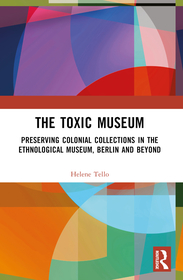
The Toxic Museum
Berlin and Beyond
- Publisher's listprice GBP 42.99
-
20 538 Ft (19 560 Ft + 5% VAT)
The price is estimated because at the time of ordering we do not know what conversion rates will apply to HUF / product currency when the book arrives. In case HUF is weaker, the price increases slightly, in case HUF is stronger, the price goes lower slightly.
- Discount 20% (cc. 4 108 Ft off)
- Discounted price 16 430 Ft (15 648 Ft + 5% VAT)
Subcribe now and take benefit of a favourable price.
Subscribe
20 538 Ft

Availability
Estimated delivery time: In stock at the publisher, but not at Prospero's office. Delivery time approx. 3-5 weeks.
Not in stock at Prospero.
Why don't you give exact delivery time?
Delivery time is estimated on our previous experiences. We give estimations only, because we order from outside Hungary, and the delivery time mainly depends on how quickly the publisher supplies the book. Faster or slower deliveries both happen, but we do our best to supply as quickly as possible.
Product details:
- Edition number 1
- Publisher Routledge
- Date of Publication 29 August 2025
- ISBN 9781032526355
- Binding Paperback
- No. of pages286 pages
- Size 234x156 mm
- Weight 530 g
- Language English
- Illustrations 18 Illustrations, black & white; 18 Halftones, black & white; 12 Tables, black & white 691
Categories
Short description:
The Toxic Museum examines the use of pesticides in German museum collections at the end of the 19th and early 20th centuries.
MoreLong description:
The Toxic Museum examines the use of pesticides in German museum collections at the end of the 19th and early 20th centuries.
It reconstructs the research of substances against harmful insects in museum collections within the historical context of the formation of nation-states, colonialism, a strengthening chemical industry, the First World War, and the resulting broad-based hygiene movement through the lens of the Ethnologisches Museum (Ethnological Museum) in Berlin. Because of their persistence, the consequences of the use of pesticides in museum collections are now unmistakable and well documented in many places. Numerous objects are highly contaminated and are only accessible under difficult conditions regarding occupational health and safety. This creates obstacles for conservation and scientific processing, as well as for mediation in the context of exhibitions and external loans. The most precarious and difficult situations arise when contaminated museum objects are repatriated to their countries of origin. This monograph examines contemporary challenges in the 21st century museum landscape and contextualises the history of pesticide use at the turn of the 20th century.
The Toxic Museum will be of great interest to students and scholars working in conservation, museology, monument preservation, art and cultural studies, ethnology, history, and economics.
MoreTable of Contents:
PART I Social and political currents from the end of the 19th to the beginning of the 20th century; 1. The nation-state of Prussia, colonialism, and the age of industrialization; 2. The First World War and the hygiene movement; 3. The development of storage and plant protection; PART II Conservation of cultural property from organic materials for the prevention and control of harmful insects in museum collections; 4. Definition of pesticides; 5. Control of wood-destroying insects, textile pests, and harmful insects on natural history objects; 6. Protective and human toxic effect of historical pesticides and their suitability test; 7. Typological recording of pesticides PART III Collecting and preserving cultural assets in Berlin and beyond from the end of the 19th to the beginning of the 20th century; 8. Spatial conditions and personnel requirements for the preservation of collections at the Königliches Museum für Völkerkunde in Berlin from the end of the 19th to the beginning of the 20th century; 9. Explorers, collectors, and adventurers at the Königliches Museum für Völkerkunde in Berlin from the end of the 19th to the beginning of the 20th century; 10. Active ingredients and agents for the protection of persons and goods on expeditions; 11. Developments and experiments on pest control at the Königliches/Staatliches Museum für Völkerkunde in Berlin; 12. Knowledge transfer and product application from industry, commerce, and trade at the Königliches/Staatliches Museum für Völkerkunde in Berlin; 13. Orders and consequences for the use of pesticides at the Königliches/Staatliches Museum für Völkerkunde in Berlin from the end of the 19th to the beginning of the 20th century; 14. Knowledge transfer, exchange, and dissemination of knowledge at the national and international level; 15 Implementation of pest control measures in national and international context during the period under investigation
More



